The Rio de Janeiro Harbor, also known as Guanabara Bay (Baía de Guanabara in Portuguese), is one of the world’s largest natural bays. Located in Rio de Janeiro, Brazil, on the country’s southeastern coast, the harbor opens to the South Atlantic Ocean.
While the most recognizable aspect of Rio de Janeiro is its statue known as Christ the Redeemer, the harbor it surrounds is just as fascinating. It gives the city stunning landscapes, plus is home to popular tourist attractions and great wildlife. Keep reading to discover more about the Rio de Janeiro Harbor’s depth and history.
The Founding of Rio de Janeiro
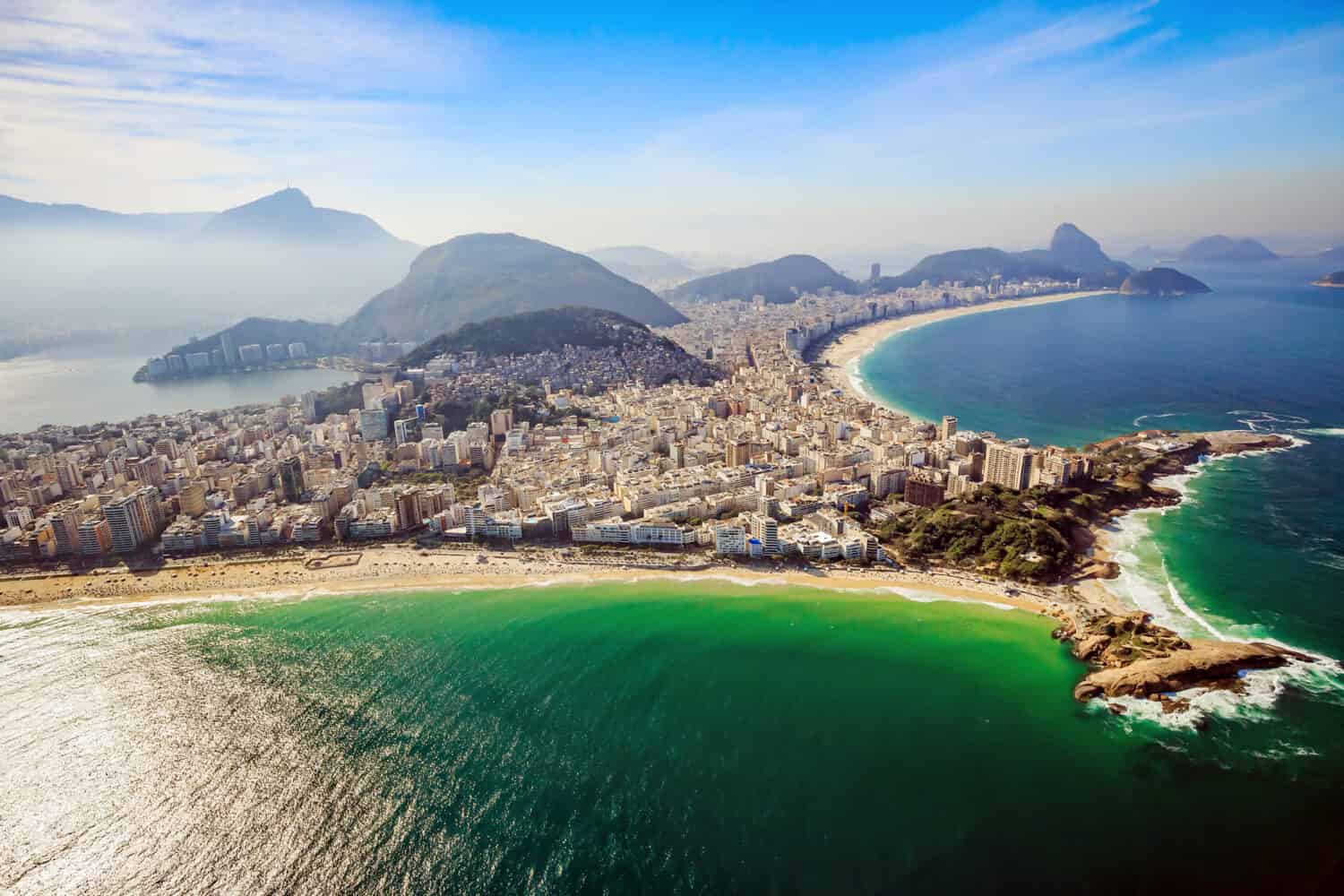
Rio de Janeiro was Brazil’s capital for two centuries before being replaced by Brasilia in 1960.
©f11photo/Shutterstock.com
The founding of Rio de Janeiro relates to the early colonial history of Brazil and Portuguese exploration in the New World. In March 1502, Portuguese explorer Gaspar de Lemos sailed into the magnificent Guanabara Bay, which he initially believed to be the mouth of a great river. Entranced by the bay’s natural beauty and strategic location, he named it “Rio de Janeiro,” which translates to “River of January” in Portuguese, referring to the month of its discovery.
However, the initial settlement of Rio de Janeiro occurred over half a century later. In 1555, French Huguenots led by Nicolas Durand de Villegagnon established a fort on one of the bay’s islands, aiming to create a Protestant stronghold. This provoked the Portuguese crown, who saw the bay’s potential, to take action. In 1565, they sent an expedition led by Estácio de Sá to oust the French and establish a permanent Portuguese presence. The successful expulsion of the French marked the actual founding of Rio de Janeiro as a Portuguese colony.
Rio de Janeiro rapidly grew in importance as a Portuguese colonial city. Its favorable geographic location, sheltered harbor, and proximity to sugar and coffee plantations in the region made it a thriving center for trade and commerce. The city also served as a significant hub for the transatlantic slave trade during the colonial era. Its economy flourished as it became a port for exporting Brazil’s agricultural products to Europe.
Over the centuries, Rio de Janeiro evolved into one of Brazil’s most culturally diverse and vibrant cities, shaped by waves of immigration and a rich blend of indigenous, African, Portuguese, and other influences.
How Deep Is Guanabara Bay?
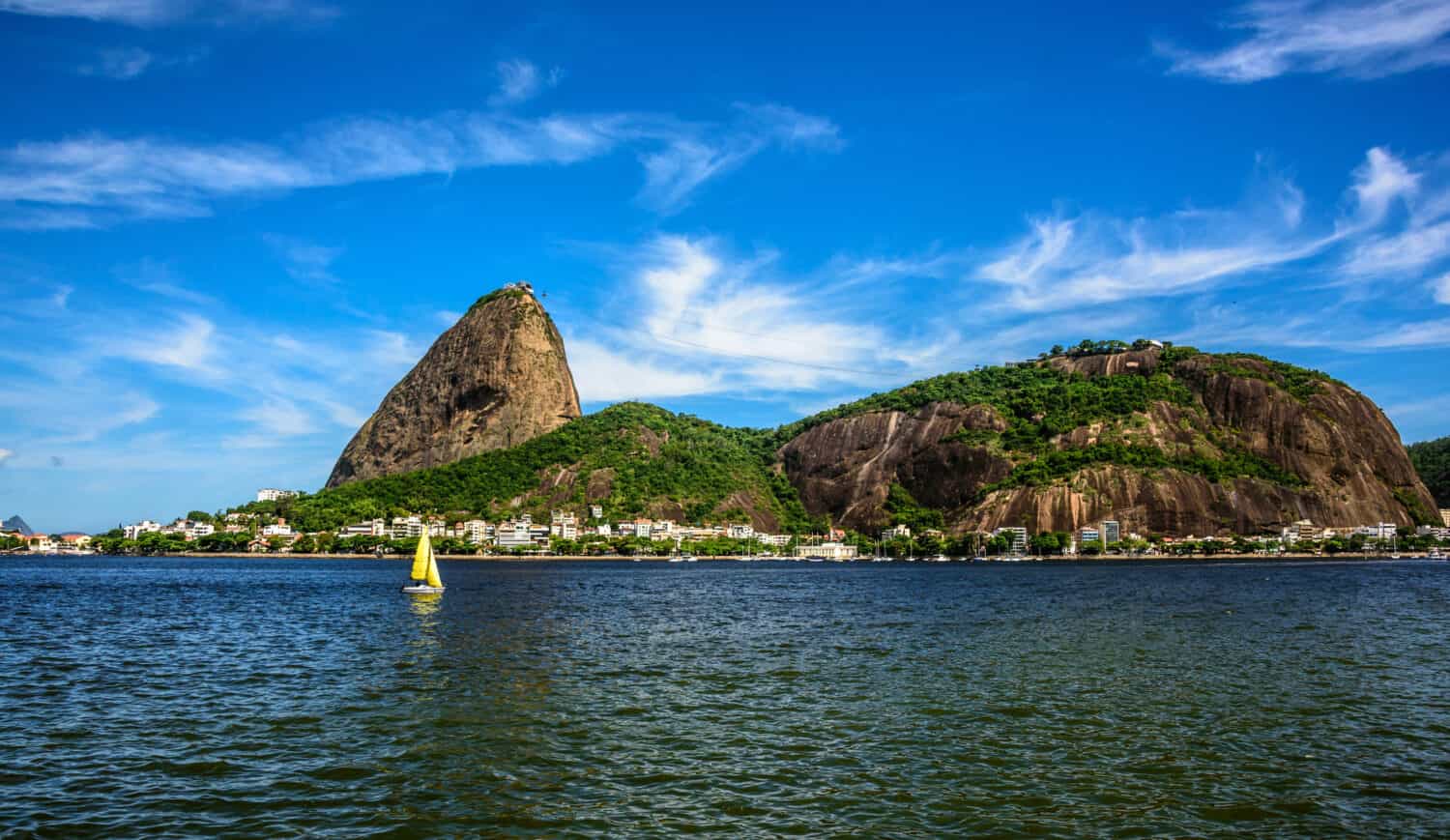
The bay is relatively shallow, allowing for some warmer water temperatures.
©Sergio Shumoff/Shutterstock.com
Guanabara Bay is relatively shallow, with varying depths across its expanse. The average depth of the bay is approximately 18.7 feet (5.7 meters). However, the bay’s depth can be quite variable, with some areas reaching depths of up to 56 feet (17 meters) or more in certain spots, while others are considerably shallower.
The varying depths of Guanabara Bay are influenced by sedimentation, underwater topography, and the flow of rivers into the bay, which can deposit sediments and affect water depths in different parts of the bay. The bay’s unique geography and intricate network of islands, bays, and channels contribute to its shallow and complex underwater terrain.
Despite its variable depths, Guanabara Bay is still very easily navigable.
How Wide Is Guanabara Bay?
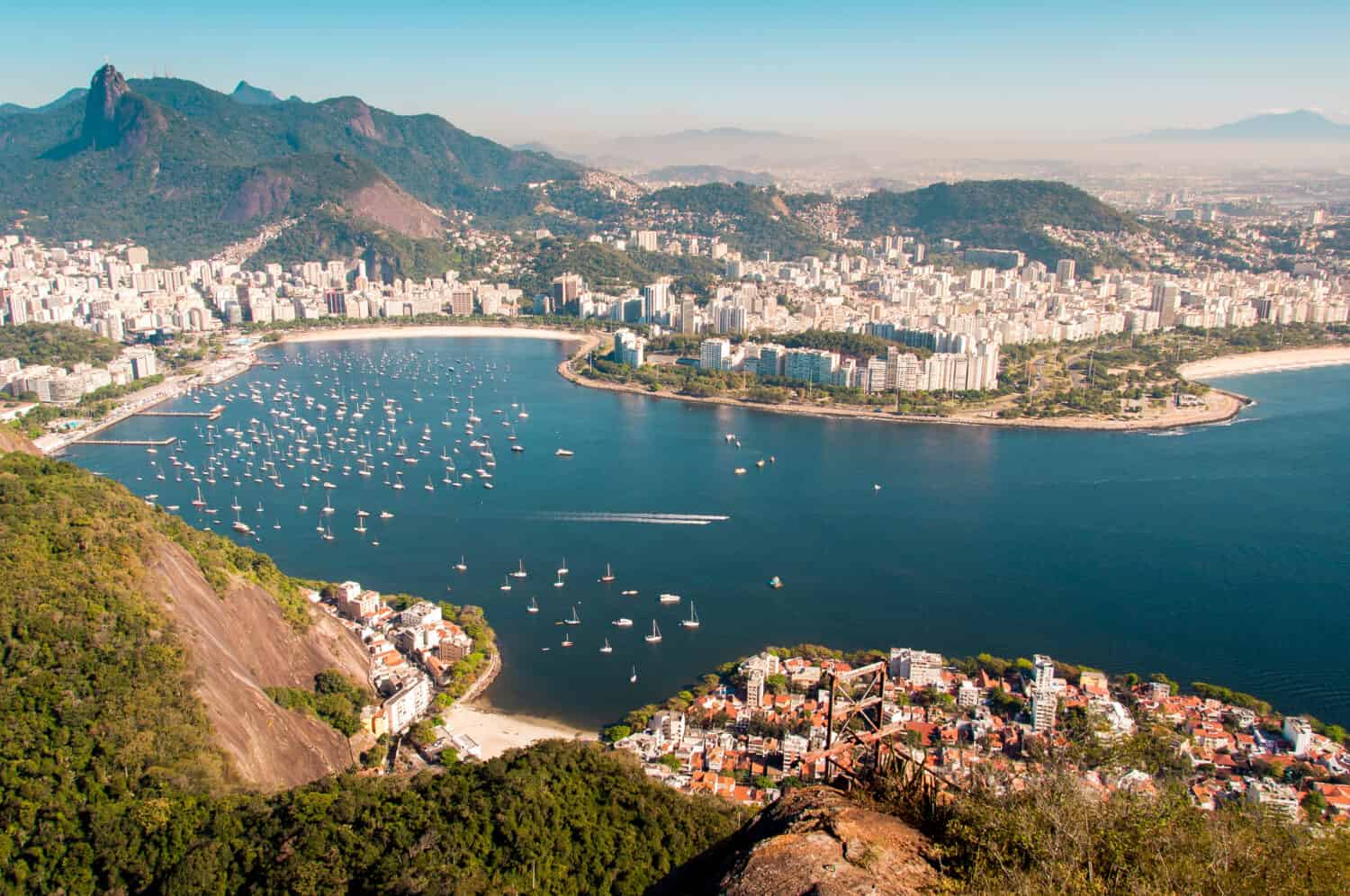
Rio de Janeiro’s Harbor is one of the largest bay in the world.
©Donatas Dabravolskas/Shutterstock.com
Guanabara Bay is approximately 19 miles (31 kilometers) wide at its widest point. This measurement is taken from the easternmost tip of the bay near the city of Niterói to the westernmost point near the entrance to the Atlantic Ocean.
Guanabara Bay is known for its vast expanse and natural beauty, surrounded by iconic landmarks such as Sugarloaf Mountain and the Christ the Redeemer statue. It plays a vital role in the region’s maritime activities and is a significant part of Rio de Janeiro’s landscape.
How Was Guanabara Bay Formed?
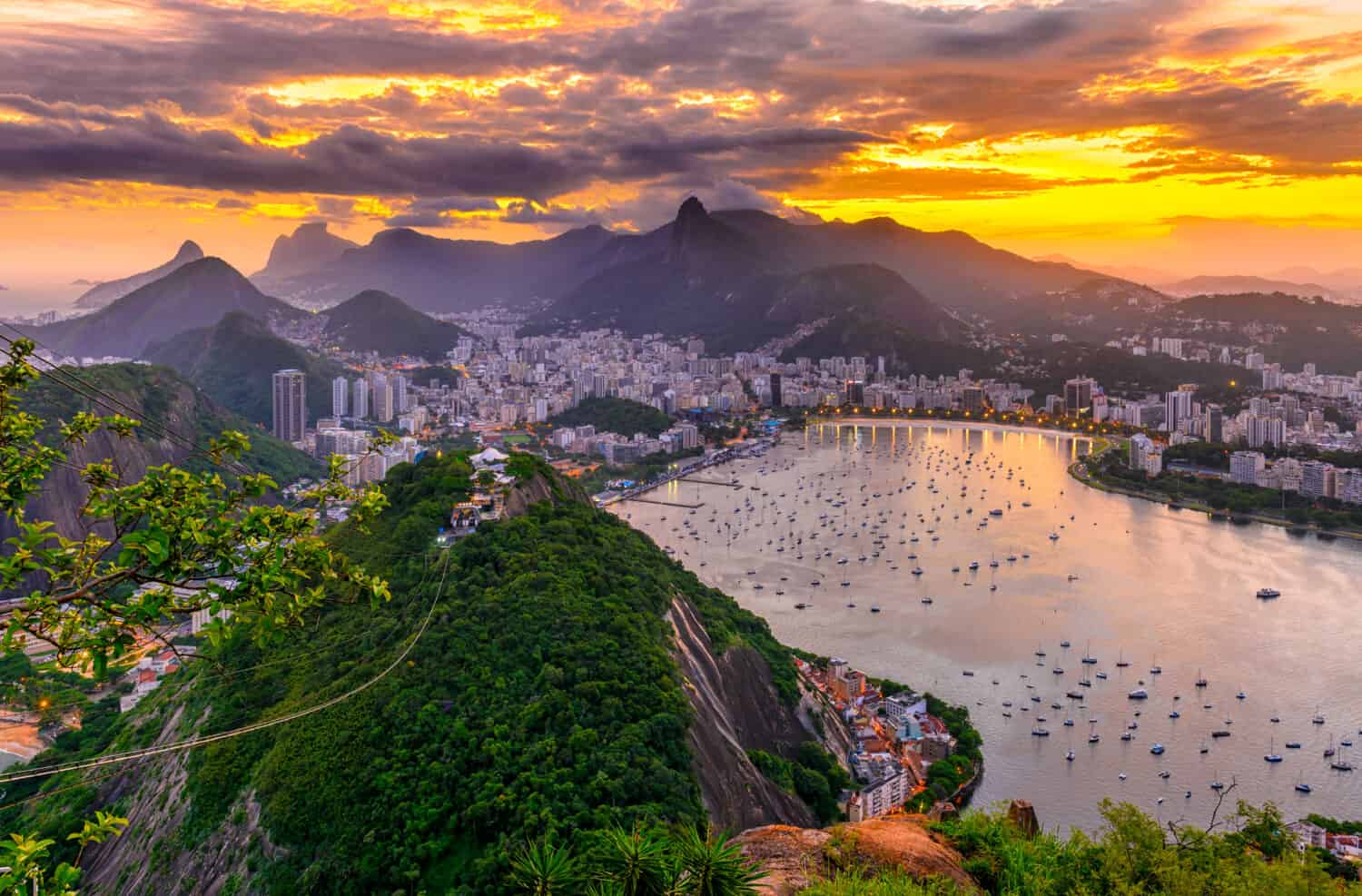
Erosion over thousands of years highly contributed to the harbor’s formation.
©Catarina Belova/Shutterstock.com
The foundation for Guanabara Bay’s formation goes back to tectonic plate movements. The region is near a tectonic plate boundary, where the South American Plate meets the African Plate. Over time, the movements and interactions of these plates led to the uplift of the land and the creation of the surrounding mountainous terrain.
Erosion played a significant role in shaping the landscape around the bay. The rivers in the area, particularly the Paraíba do Sul River, carried sediments from the interior to the coast. These sediments were deposited along the coastline, gradually forming a deltaic system and sedimentary deposits that helped create the shallower areas within the bay.
Throughout Earth’s history, sea levels have fluctuated. During lower sea levels, river valleys and estuaries may have been exposed and subjected to erosion. Conversely, these areas could have become inundated during higher sea levels, forming bays and inlets. These natural fluctuations in sea levels likely influenced the overall shape and depth of Guanabara Bay.
Over countless geological cycles, these processes shaped Guanabara Bay into the picturesque and sheltered harbor it is today. The bay’s stunning scenery and strategic location make it one of Brazil’s most iconic and historically significant geographic landmarks.
Where Is Guanabara Bay Located on the Map?
Guanabara Bay is on the southeastern coast of Brazil, specifically in the state and city of Rio de Janeiro. The city is the second most populated in Brazil, after São Paulo, with over 6 million inhabitants.
The bay is considered one of the largest in the world and provides a sheltered harbor to the city of Rio and others.
What Wildlife Live In and Near Guanabara Bay?

Various species of turtles live in the Rio de Janeiro Harbor.
©pniesen/iStock via Getty Images
The bay’s mix of coastal, estuarine, and marine habitats provides a habitat for numerous species of flora and fauna.
Marine Species
Dolphins are a common sight in the bay. Guiana dolphins and bottlenose dolphins are among the species frequently spotted. On rare occasions, humpback whales visit the bay during their migration seasons.
The bay has many fish species, including mullet, snook, catfish, and anchovies. The bay’s estuarine environment provides essential nursery and breeding grounds for many marine species. Various crabs and shrimps inhabit the bay’s shallow waters and mudflats. They are an integral part of the local food web.
Several sea turtles, such as loggerhead and green turtles, live in the bay and its adjacent coastal waters. These turtles use the bay as foraging grounds.
Birds
A diverse array of bird species frequents Guanabara Bay. Visitors can spot waterbirds like herons, egrets, and cormorants along the shoreline. The bay also serves as a stopover and foraging area for migratory birds. There are also various seabirds, including seagulls and terns.
Flora
The mangrove forests along the bay’s shoreline provide critical habitats for many species, including crabs, mollusks, and juvenile fish. Mangroves serve as important bird breeding grounds and act as buffers against coastal erosion.
The vegetation along the bay’s coast includes mangroves, salt marshes, and coastal grasses. These plant communities provide habitat, food, and protection for various wildlife species.
Activities
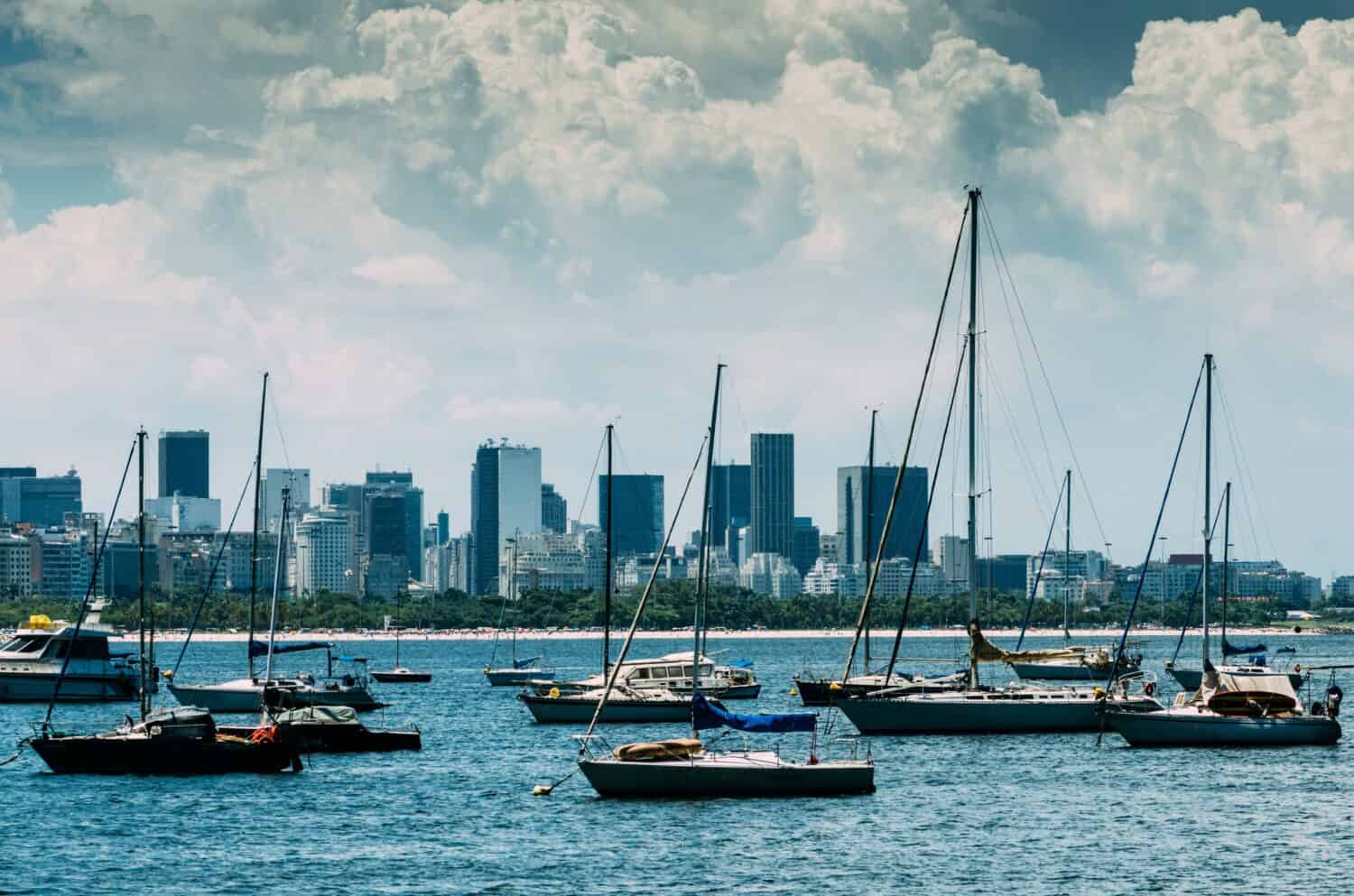
With the large expanse of the bay, boating is a popular activity.
©Alexandre Rotenberg/Shutterstock.com
Rio de Janeiro and Guanarabara Bay offer an endless array of activities.
Activities in Guanabara Bay
Go to the beach! Beautiful urban beaches surround the bay, including Flamengo Beach and Botafogo Beach. Visitors can relax on the sandy shores and play beach volleyball or football on the sand. Unfortunately, swimming on both these beaches is not recommended as the waters experience elevated pollution levels. The beaches are the perfect spot at dusk for a stunning sunset.
Guanabara Bay is a popular destination for sailing enthusiasts. You can rent a sailboat or join a guided sailing tour to explore the bay’s calm waters while enjoying stunning views of Rio de Janeiro’s iconic landmarks. Visitors can also pick the option of hopping on a guided boat tour. These provide historical information about the bay and take visitors to key landmarks, including the Rio-Niterói Bridge and Fort São João.
But boating isn’t the only water activity you can do! Canoeing, kayaking, and paddleboarding are great ways to explore the bay at your own pace. Plenty of shops offer rentals for visitors to enjoy the bay waters. Guided tours are also available for those who want to learn about the city while cruising on the water.
The area is also a popular spot for recreational fishing. Visitors can try to catch various types of fish while enjoying the peaceful atmosphere of the bay. It is also ideal for birdwatching, as spotting different birds along the shoreline and surrounding mangroves is easy.
For land activities, many scenic bike paths and trails run alongside the bay, making it an excellent place for cycling. Various rentals are available and offer visitors the opportunity to explore the shoreline.
Activities in Rio de Janeiro
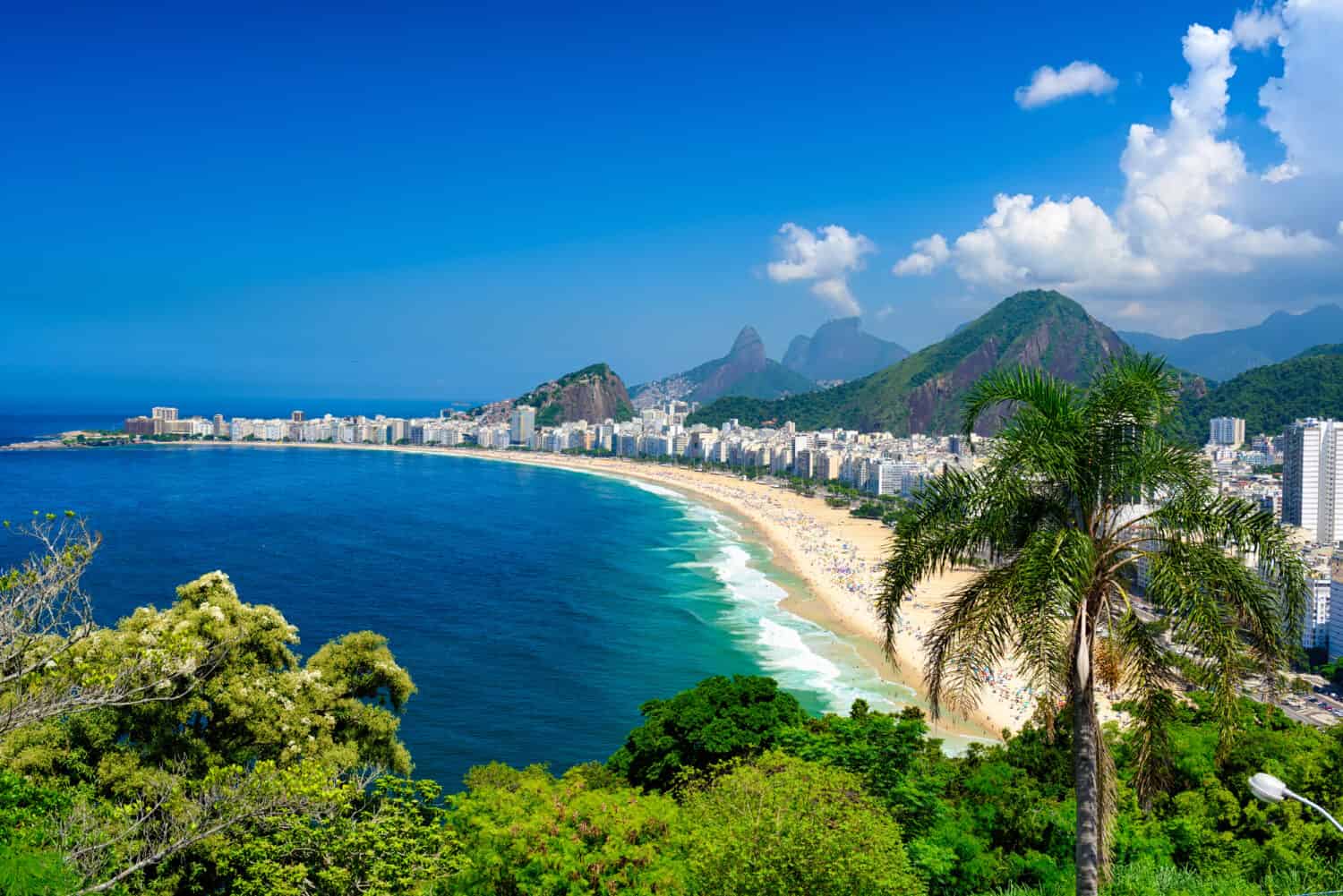
Copacabana is a must-see in Rio de Janeiro.
©Catarina Belova/Shutterstock.com
The most famous activity in Rio de Janeiro is to head to the Christ the Redeemer statue atop Corcovado Mountain. Visitors can reach the summit via a train ride or multiple hikes to enjoy panoramic city views. For more stunning views of the bay and city skyline, take a cable car ride to Sugarloaf Mountain (Pão de Açúcar) for spectacular views.
Explore the most famous beaches of Rio, Copacabana and Ipanema. These are perfect for a relaxing day, beach volleyball, and sunbathing. Unlike Guanabara Bay, there is no concern for pollution, so taking a dip is almost a must-do!
Take some time to visit historic sites. Explore Rio’s colonial past by visiting historical sites like the São Bento Monastery, the Royal Portuguese Reading Room, and the Imperial Palace. Explore Rio’s cultural and artistic side by visiting museums like the Museum of Modern Art (MAM), the National Museum, and the Museum of Tomorrow (Museu do Amanhã) or the Naval Museum (Museu Naval).
Hiking fan? Head out to Tijuca Forest. This urban rainforest offers numerous trails and waterfalls. The hike to the summit of Pedra da Gávea is a hidden gem and rewards hikers with a stunning view of Rio. The Rio de Janeiro Botanical Garden (Jardim Botânico) is also worth a visit.
Visitors should not go to Rio de Janeiro without trying their delicious food. Sample local dishes such as feijoada (a black bean stew with pork), coxinha (deep-fried chicken snacks), and açaí bowls at street markets and restaurants. The best food is often at local markets like the Hippie Fair in Ipanema and the Feira de São Cristóvã.
If sports enthusiasts, visitors should try to attend a soccer game at the iconic Maracanã Stadium.
Christ the Redeemer
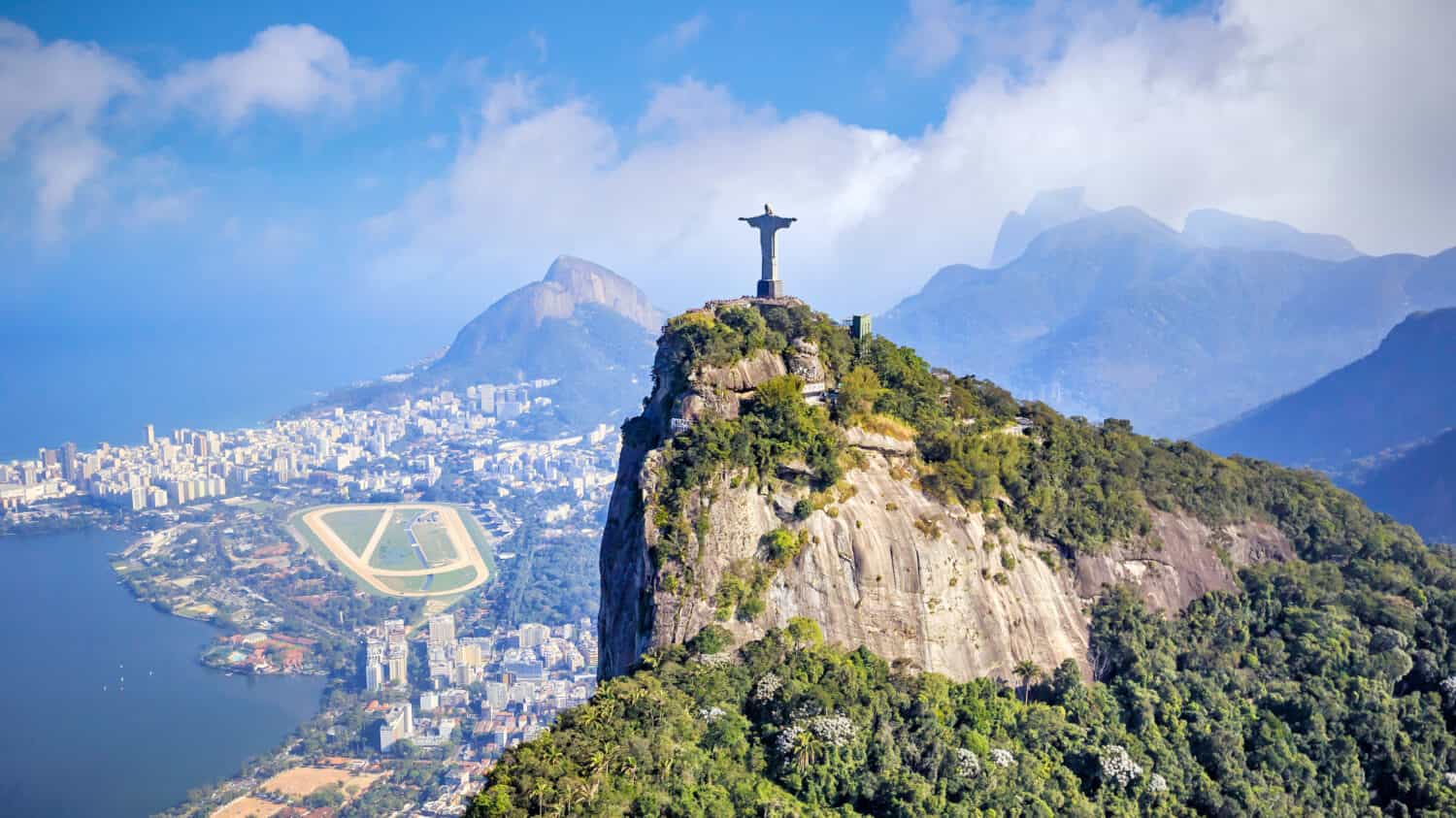
In 2007, the statue became one of the World’s New Seven Wonders.
©f11photo/Shutterstock.com
Christ the Redeemer, or “Cristo Redentor” in Portuguese, is Brazil’s most iconic landmark. Perched atop the Corcovado Mountain overlooking Rio de Janeiro, this Jesus Christ statue symbolizes faith, peace, and Brazilian culture.
The idea for the statue emerged in the late 19th with discussions around creating a religious monument to symbolize Brazil’s strong Christian heritage. In 1921, Brazilian engineer Heitor da Silva Costa and French sculptor Paul Landowski won the competition to build the statue.
Construction started in 1926 and was completed in 1931. The statue is 98 feet (30 meters) tall, and with its pedestal and the mountain’s elevation, it reaches a total height of 125 feet (38 meters). It was built with reinforced concrete and soapstone, which allowed the statue to withstand the test of time.
With its outstretched arms, it symbolizes its embrace of all humanity. The statue represents Jesus Christ’s role as a universal redeemer and savior, embodying messages of love, compassion, and forgiveness.
It holds immense religious significance for Christians in Brazil and worldwide. It is a place of pilgrimage and prayer. Many visitors journey to the summit to offer their prayers and seek spiritual solace. The statue has also hosted numerous religious events and ceremonies.
Visiting Christ the Redeemer is a popular activity for tourists and locals alike. Visitors can reach the summit via a scenic train ride through Tijuca National Park or hiking on designated trails. Once at the summit, visitors can admire breathtaking panoramic views of Rio de Janeiro, Guanabara Bay, and the surrounding landscape.
Rio de Janeiro Carnival “Carnaval”
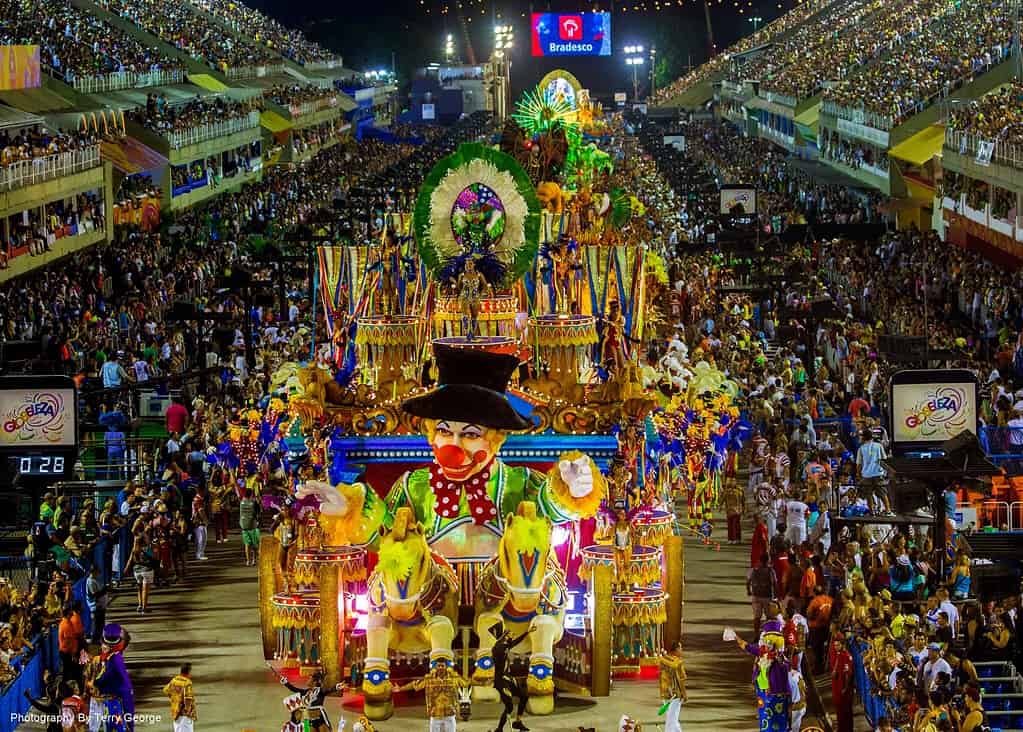
Approximately two million locals and visitors participate and attend the carnival each day. The Rio Carnival lasts five days.
The Rio de Janeiro Carnival is the world’s most famous and spectacular festival. This vibrant celebration, deeply ingrained in Brazilian culture, attracts millions of visitors from around the globe each year. The Rio de Janeiro Carnival reflects Brazil’s cultural diversity, creativity, and resilience. It allows Brazilians to express their identity and celebrate their heritage.
The extravagant and colorful costumes participants wear are a hallmark of the Rio Carnival. These are usually elaborate, adorned with feathers and sequins. Many participants also wear masks and face paint, keeping their anonymity, a trait that characterizes the carnival.
The heart of the Rio de Janeiro Carnival lies in the samba schools. The schools compete in a spirited parade competition in the Sambadrome, a massive purpose-built parade stadium in Rio de Janeiro.
Each samba school prepares for the carnival throughout the year. They craft intricate costumes, compose original samba songs, and rehearse dance routines. The parades are a breathtaking spectacle of color, rhythm, and creativity, featuring massive floats, thousands of costumed dancers, and percussion ensembles to keep the crowd dancing throughout the night.
During the carnival, the streets of Rio de Janeiro come alive with countless street parties known as “blocos.” These range from small neighborhood gatherings to massive, city-wide celebrations. Participants and spectators gather to dance, sing, and enjoy the infectious music of samba, funk, and other Brazilian genres. Some of the most famous include “Cordão da Bola Preta” and “Suvaco do Cristo.”
The photo featured at the top of this post is © Mihai_Andritoiu/Shutterstock.com
Thank you for reading! Have some feedback for us? Contact the AZ Animals editorial team.







